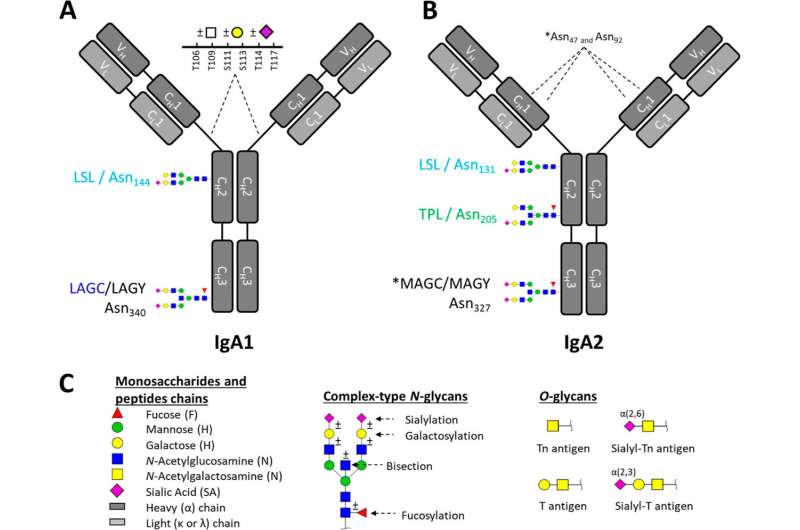
Millions of Americans have inflammatory bowel disease (IBD), which occurs in one of two forms: Crohn’s disease or ulcerative colitis. Though the two have similar symptoms, they require different treatment strategies, and tests to distinguish between them are invasive. Reporting in the Journal of Proteome Research, researchers now show that chains of sugar molecules are tacked onto antibodies differently in patients with the diseases, which could someday lead to a simple blood-based diagnostic test.
Though Crohn’s disease and ulcerative colitis have similar symptoms and unknown causes, they affect disparate parts of the gastrointestinal tract and therefore require different therapies. Currently, distinguishing between the two typically requires invasive procedures, such as an endoscopy or biopsy. To develop a less uncomfortable option, some researchers are searching for biomarkers in blood or other easily accessible body fluids.
Antibodies, also known as immunoglobulins, could serve as biomarkers, given that immunoglobulin G (IgG) was previously shown to play a role in autoimmune diseases, including IBD. But another class, immunoglobulin A (IgA), could play a role as well, because it functions within the mucous membranes that cover and protect internal organs, such as the intestinal tract.
These immune molecules can be decorated with chains of sugars called glycans, and this can affect their structure and function. Since Crohn’s disease and ulcerative colitis both affect the intestinal tract, Manfred Wuhrer and colleagues wanted to understand how IgA glycosylation might differ between these two diseases.
To investigate these glycosylation patterns, the researchers analyzed over 400 clinical plasma samples from patients with either form of IBD, alongside nearly 200 healthy controls. Using a combination of liquid chromatography and mass spectrometry, they found over 30 different forms of the IgA1 and IgA2 antibodies. The glycans differed between the three experimental groups.
The Crohn’s disease patients had IgAs with fewer branched sugars, but more glycosylation overall compared to other groups. Ulcerative colitis patients had more glycans attached to the opposite end of the IgA protein chain than the control group. These patterns were used to construct a preliminary statistical model that could predict the disease group, and the model could be expanded further to be used as a diagnostic tool. The researchers say that this work could help make diagnosing IBD easier and less invasive for patients.
More information:
Florent Clerc et al, Immunoglobulin A Glycosylation Differs between Crohn’s Disease and Ulcerative Colitis, Journal of Proteome Research (2023). DOI: 10.1021/acs.jproteome.3c00260
Journal information:
Journal of Proteome Research
Source: Read Full Article